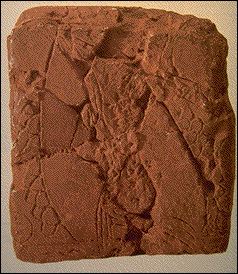 |
 |


|
Clay Tablet map from
Ga-Sur from about 2500 B.C.
Image © Jim Seybold
used by permission
|
|
Map
An image that represents graphically the position of elements in the real world. The idea of representing the relative positions of geographic features as a drawing is extremely ancient, and appears to be as old or older than writing itself. A rock painting from Catal Hyük in Turkey shows the plan of a village and has been carbon dated to 6200 B.C., while a map on a Sumerian clay tablet dates from about 2500 B.C. and shows mountains and a river. Today satellites and airplanes enable cartographers to make geographic maps of unprecedented accuracy and detail.
The English word "map" comes from the Latin "mappa," or "napkin," because maps were often drawn on fabric. Cloth maps are cheap, light, durable, and easily stored -- advantages that applied both to ancient cloth navigational maps and to early 20th-century silk aeronautical charts. Originally the term for a map was "mappamundi," or "map of the world," sometimes also used to refer to the entire earth itself. This entered French as "mappemonde" and eventually became shortened to its present form of "map" as the meaning broadened to include any kind of graphic plan. Thus today a web site can have a "site map" that shows the virtual relationships between its elements, even though no physical objects are involved.
Modern maps serve a nearly infinite variety of uses, from displaying the arrangement of stores in a shopping mall to indicating the ages of underlying geological strata to marking the positions of stars. Most people take maps for granted, wearing lapel pins in the shape of their home state or drawing crude route maps for party invitations without pausing to marvel at the inherent sophistication of the underlying concept.
Copyright © 1999, 2000 media.org.
|
 |

